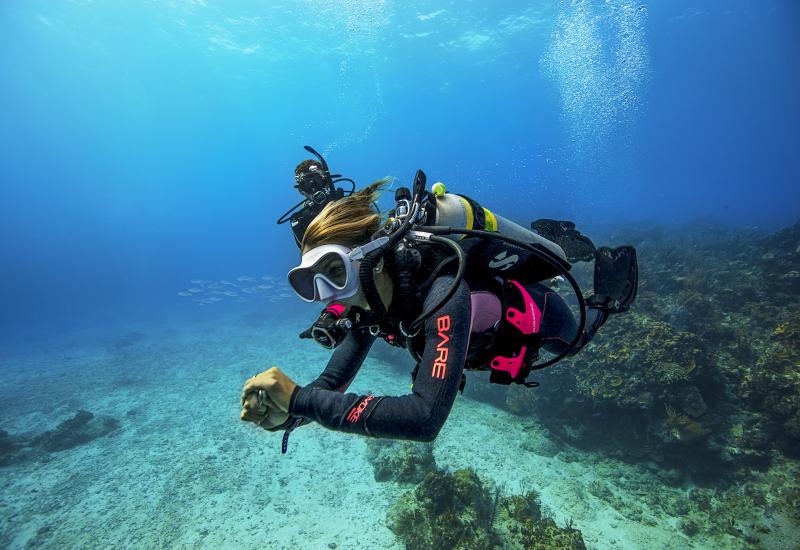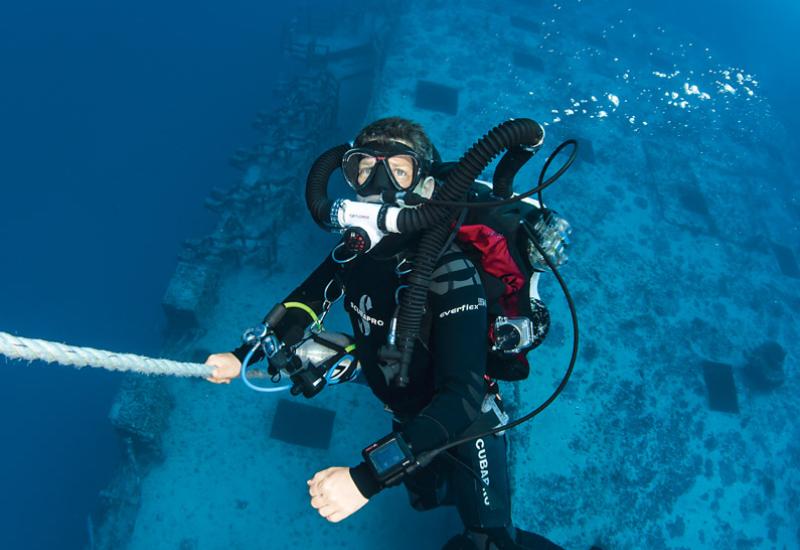Dive Training: How To Deal With Crowded Dive Boats
You awake with only one thing on your mind: “It’s the perfect day for a dive.” Conditions are ideal — eye-poppingly blue skies, sheet-glass seas, endless visibility. A pod of dolphins is launching barrel rolls over the boat’s bow wake as you pull up to the site that’s been on your bucket list for years. This is the stuff of divers’ dreams. There’s just one problem — 36 strangers on the boat all had the same idea. And by the looks of their nervous grins and fumbling ways, they’re fresh from learning to clear their masks in a far-off YMCA pool.
Let’s face it: Unless you’re pioneering uncharted waters in a remote corner of Earth, crowds are a part of diving. It’s the rare day when you get the boat to yourself. How you deal with high human density can make or break a good time. Kell Levendorf, director of training for Divers Direct, based in Key Largo, Florida, works in one of the most popular dive destinations in the United States. In the past 30 years, the veteran dive instructor has shepherded flocks of students on jam-packed dive boats and sites. Along the way, Levendorf has learned a few useful crowd-control tricks.
TIDY UP YOUR NEST
The key to harmony on the dive deck is keeping your kit organized. “Police your area,” says Levendorf. “I have my guests set up their gear very specifically, so their fins are secured behind the tank, their mask is hanging on the spare tank and everything is safely secured with the bungee cord. If there’s a separate weight system, it should be on the deck tucked underneath so no one will trip over it. A diver should be able to sit down and gear up in one place, and go straight into the water. When divers have their gear spread all over the boat, bad things happen.”
MINIMIZE MISTAKEN IDENTITIES
When there are three-dozen divers at depth — and most are wearing black — it can be easy to lose track of your buddy or guide. “Keep a mental picture of your buddy’s gear,” Levendorf recommends. “Look for unique equipment, noticeably different colors or any other attention-grabbing details that you can use to quickly recognize him or the dive leader. One of the best strategies is to memorize the shape and color of his fins.” To make his fins stand out, Levendorf uses a white paint marker to write “Follow” on one fin and “Me” on the other. “Fins are the first thing you’re going to look at during a dive and the easiest thing to see when you’re following,” he says.
SAFETY-STOP SOLUTIONS
An anchor line can become a potentially dangerous bottleneck on an over-crowded safety stop, especially when strong currents or surge add stress to already fatigued divers. Levendorf recommends employing a jon line — a simple safety line that many tec divers use to tether themselves to the down line during decompression. “I attach a carabiner-and-hook combo to my BC, secure it onto the down line and unstring 6 feet of line that helps save fatigue in my arms from holding on,” he says. For more-experienced divers in calm conditions, another solution is the fabled “human jon line,” in which divers hold onto one another’s fins perpendicular to the down line, like a human centipede. “It’s a great training exercise to work on neutral buoyancy,” Levendorf says. “And it looks really cool.”
You awake with only one thing on your mind: “It’s the perfect day for a dive.” Conditions are ideal — eye-poppingly blue skies, sheet-glass seas, endless visibility. A pod of dolphins is launching barrel rolls over the boat’s bow wake as you pull up to the site that’s been on your bucket list for years. This is the stuff of divers’ dreams. There’s just one problem — 36 strangers on the boat all had the same idea. And by the looks of their nervous grins and fumbling ways, they’re fresh from learning to clear their masks in a far-off YMCA pool.

ShutterstockPatience, grasshopper: Better to wait an extra minute than giant-stride in on your buddy.
Let’s face it: Unless you’re pioneering uncharted waters in a remote corner of Earth, crowds are a part of diving. It’s the rare day when you get the boat to yourself. How you deal with high human density can make or break a good time. Kell Levendorf, forensic casualty investigator for Dive & Marine Consultants International, has worked in some of the most popular dive destinations in the United States. In the past 30 years, the veteran dive instructor has shepherded flocks of students on jam-packed dive boats and sites. Along the way, Levendorf has learned a few useful crowd-control tricks.
TIDY UP YOUR NEST
The key to harmony on the dive deck is keeping your kit organized. “Police your area,” says Levendorf. “I have my guests set up their gear very specifically, so their fins are secured behind the tank, their mask is hanging on the spare tank and everything is safely secured with the bungee cord. If there’s a separate weight system, it should be on the deck tucked underneath so no one will trip over it. A diver should be able to sit down and gear up in one place, and go straight into the water. When divers have their gear spread all over the boat, bad things happen.”
MINIMIZE MISTAKEN IDENTITIES
When there are three-dozen divers at depth — and most are wearing black — it can be easy to lose track of your buddy or guide. “Keep a mental picture of your buddy’s gear,” Levendorf recommends. “Look for unique equipment, noticeably different colors or any other attention-grabbing details that you can use to quickly recognize him or the dive leader. One of the best strategies is to memorize the shape and color of his fins.” To make his fins stand out, Levendorf uses a white paint marker to write “Follow” on one fin and “Me” on the other. “Fins are the first thing you’re going to look at during a dive and the easiest thing to see when you’re following,” he says.
SAFETY-STOP SOLUTIONS
An anchor line can become a potentially dangerous bottleneck on an over-crowded safety stop, especially when strong currents or surge add stress to already fatigued divers. Levendorf recommends employing a jon line — a simple safety line that many tec divers use to tether themselves to the down line during decompression. “I attach a carabiner-and-hook combo to my BC, secure it onto the down line and unstring 6 feet of line that helps save fatigue in my arms from holding on,” he says. For more-experienced divers in calm conditions, another solution is the fabled “human jon line,” in which divers hold onto one another’s fins perpendicular to the down line, like a human centipede. “It’s a great training exercise to work on neutral buoyancy,” Levendorf says. “And it looks really cool.”










